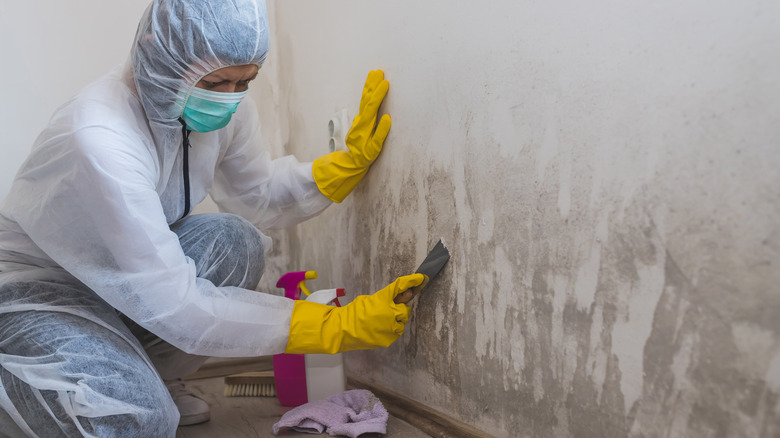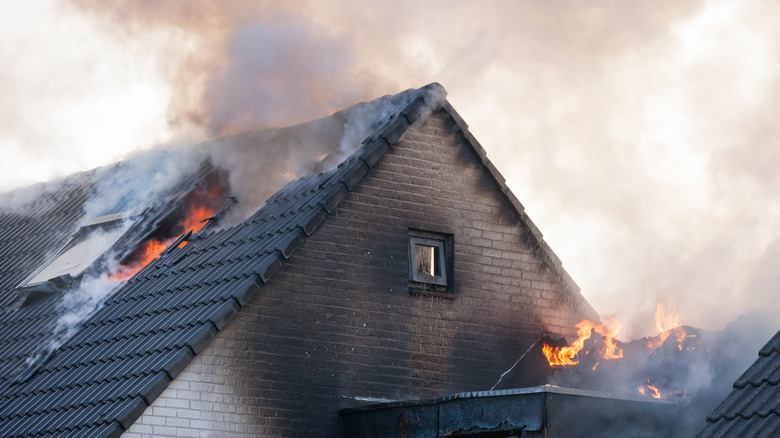If The Attic In Your New Home Is Painted White, This Is What It Could Mean
When purchasing a new home, there are a few factors you may want to consider like the number of bathrooms, amount of storage space, and age of appliances. When it comes to attics, however, our attention is rarely drawn to the many hidden dangers that may be lurking. If the attic in your new home is painted white, it may signal a bigger problem: mold remediation. Since attics are highly prone to roof leaks, insulation issues, and lack of proper ventilation, mold may begin to grow above us. Alternatively, it can also be evidence that a fire once took place in the attic and the markings were painted over by the previous owner.
Believe it or not, it's not exactly white paint that's used to cover the walls of an attic when mold is the issue, but rather a white mold sealant. Sealants are substances that contain an antimicrobial and can close the gaps in our walls and ceilings that often make room for mold, fungus, and insect infestations. Unlike the thin consistency of paint, sealants are much thicker and are used to prevent moisture from entering. Depending on the condition of your attic, a previous homeowner may have painted the walls with a permanent, semi-permanent, or removable sealant in an attempt to keep the space mold-free — but this typically doesn't fix the root problem. And if it's just painted plain white, it may be evidence that the room was once engulfed in flames.
What to do if the issue is mold
If you have your attic inspected by specialists and they confirm that it was painted white because of a mold infestation, the protocol for what to do next will most likely differ based on the type of mold. For example, black mold can cause watery eyes, headaches, and trouble breathing for those who are unknowingly allergic. Therefore, these types must be treated by a mold removal specialist to ensure the root cause of the issue is solved. However, non-toxic mold, such as allergenic types, doesn't typically require professional intervention and can be removed with a disinfecting solution.
To eliminate any trace of dangerous mold lurking in your attic, some use a thick white sealant to encapsulate the walls. However, many consider this to be a temporary solution and even a huge cause for concern. This is because, while encapsulating the space with a protective sealant is effective for surface-level issues, sealants can't reach deeper mold that may be growing. That's why it's so important to correctly remove and clean mold from your attic. Mold may also begin to grow underneath the sealant, making it even harder to fix the issue. Typically, it's best to get professional help when trying to remove mold from your home.
Your attic may have been painted white because of a fire
The attic in your new home may have also been painted white to hide evidence of smoke from an attic fire. An estimated 10,000 attic fires happen every year and can be caused by a number of problems. Attics are susceptible to electric wiring issues, dangerous weather, HVAC problems, and pests that can chew through wires, all of which can be fire hazards in extreme circumstances. If the attic isn't entirely damaged, there's usually a trace of smoke that is painted over to prevent home sellers from losing property value.
On the other hand, white fireproofing paint can also be a preventative measure used against fires. Some homeowners try to protect attic walls with a specific type of paint that can significantly decrease the likelihood of a fire engulfing the space, especially if the surrounding material is highly flammable. That's why it's important to ask your real estate agent or a professional inspector to confirm the significance of an attic painted white, as it could either be a serious issue or a beneficial covering.


